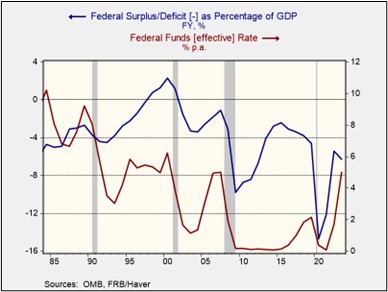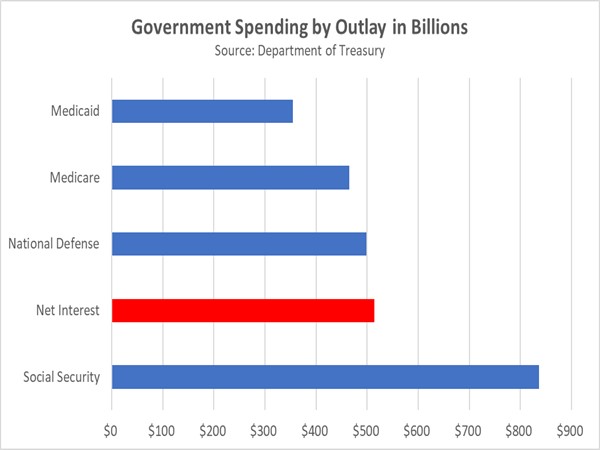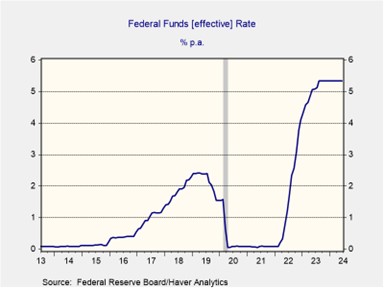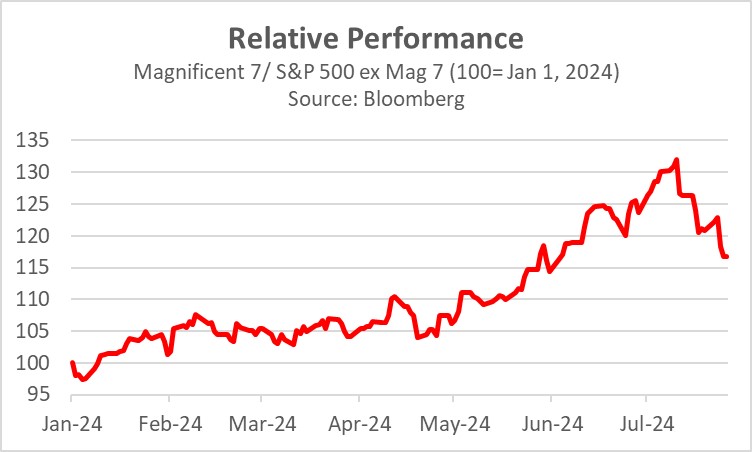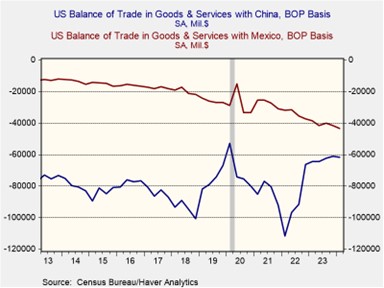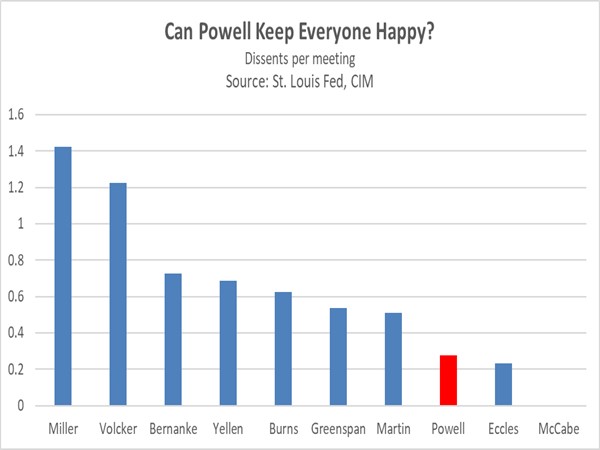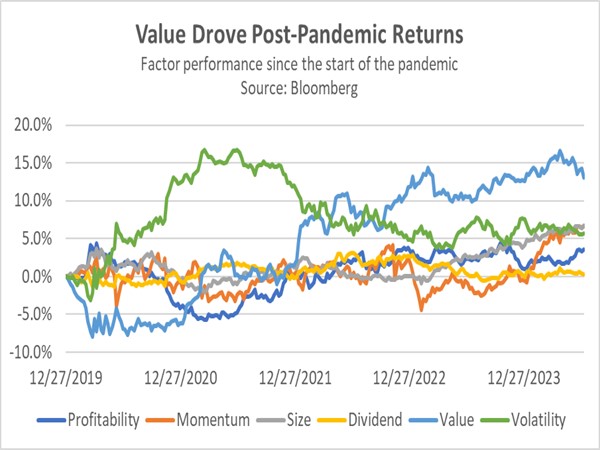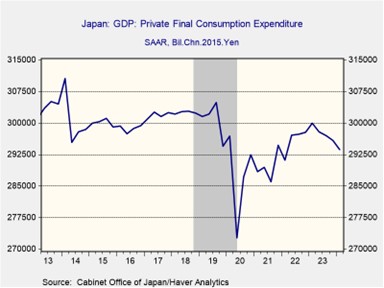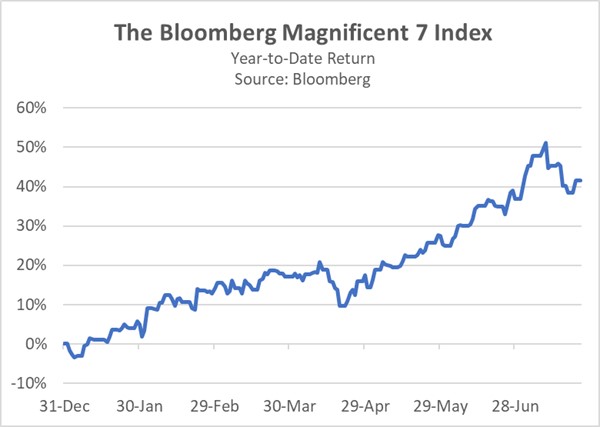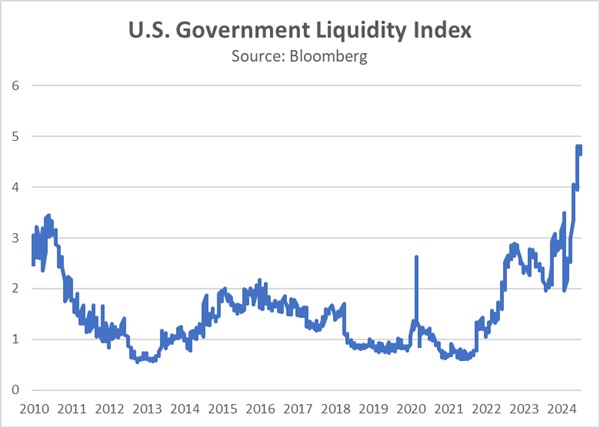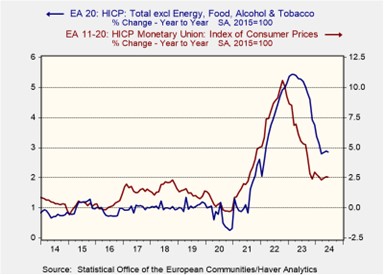Author: Amanda Ahne
Asset Allocation Bi-Weekly – The Price of Central Bank Independence (July 29, 2024)
by the Asset Allocation Committee | PDF
Despite the formal separation of the Federal Reserve and Treasury Department in 1951, the two bodies continued to collaborate closely on economic policy for nearly two decades. The coordination aimed to improve the effectiveness of initiatives like stimulating economic growth or preventing the overheating of the economy. While this balancing act worked well under Bretton Woods, the system’s collapse in the 1970s strained the relationship between the two institutions.
The end of the gold-dollar exchange system in the early 1970s left the United States struggling to maintain confidence in its currency. Foreign leaders, like Charles de Gaulle of France, had previously been critical of America’s inability to control spending and argued that it devalued the dollar held by other countries. This anxiety surrounding the dollar likely played a role in Saudi Arabia’s decision to hike oil prices and impose an oil embargo on the US in response to its involvement in the Arab-Israeli War. This move significantly contributed to a surge in US inflation.
To address this, President Jimmy Carter delivered his now-famous “malaise” speech and requested resignations from his White House staff and cabinet. As part of this reshuffle, he appointed Paul Volcker as Fed Chair. This decision, though, cost him his presidency and established a precedent for the Fed to prioritize its monetary policy goals, even if they diverged from fiscal policy during economic expansions.
Investors tend to favor policies that nurture economic growth while also keeping inflation in check. This balancing act can be tricky, but the Federal Reserve’s approach exemplifies how it’s done. As the chart below shows, the Fed typically lowers interest rates during recessions to jumpstart the economy. Conversely, during economic booms, it usually tightens policy to slow borrowing and spending, keep the economy from overheating, and prevent inflation. This strategy resonates with investors because it ensures that they’re compensated for potential inflation and the risks associated with rising government debt.
However, what benefits financial markets doesn’t always translate to political popularity. Lawmakers, especially populists, have clashed with the Fed when its actions run counter to their agendas. Former President Donald Trump frequently lambasted the Fed for raising rates while he was working to stimulate economic growth through lower tax rates. Meanwhile, Massachusetts Senator Elizabeth Warren has accused the central bank of raising interest rates to the detriment of its inflation target, suggesting that its hiking cycle contributed to rising shelter and insurance prices.
Rising debt has further strained the relationship between the central bank and lawmakers. The gross federal debt as a percentage of GDP rose from 100.5% in 2019 to 126.4% in 2020. While some progress has been made in reducing the debt, Fed officials have warned that the government should do more to rein in its spending to prevent a rising debt problem. The Congressional Budget Office projects that weaker economic growth and higher interest rates could push the debt to 140% of GDP by 2034.
The government’s recent shift toward issuing more short-term bills exposes it to greater interest rate fluctuations, further complicating the Fed’s ability to shield itself from scrutiny. According to one estimate, the government issued 70% of its Treasury debt in bills this year. This means future rate hikes by the Fed could significantly increase the government’s borrowing costs. Highlighting the urgency of the issue, the cost of servicing the debt (net interest) has surpassed military spending in the first seven months of fiscal year 2024, as shown in the chart below.
The rising tensions between the Fed and the government have likely fueled concerns about the effectiveness of their independent roles, prompting some to question whether the Fed and the government should return to their pre-Volcker relationship. Some lawmakers have pushed for the executive branch to have more say in future monetary policy. The new framework would require central bankers to consult with the president on interest rate decisions and grant him the authority to dismiss the central bank head if he disapproves.
A weakened central bank could lose its ability to act as a critical check on excessive government spending. This scenario raises concerns for bondholders, who could face the brunt of rising inflation if fiscal spending spirals out of control. Further compounding the uncertainty, foreign entities may be hesitant to hold US dollars due to a perceived lack of clear policy direction. This could lead them to diversify their reserves, seeking assets like gold that might offer a more stable store of value.
Despite no direct challenges to Fed independence from the current presidential candidates, anxieties linger about potential meddling. This could dampen investor enthusiasm for US financial assets and exacerbate market volatility as the election nears. However, a silver lining exists for some. International companies and US companies with foreign currency exposure could benefit from a potentially weaker dollar, translating to higher returns.
Daily Comment (July 26, 2024)
by Patrick Fearon-Hernandez, CFA, and Thomas Wash
[Posted: 9:30 AM ET] | PDF
Good morning! S&P 500 futures are higher as investors remain optimistic about a Fed pivot. The USWNT boosted spirits with a crucial victory over Zambia, keeping their Olympic quest for gold alive. Today’s Comment will dissect the latest GDP data and its potential impact on Fed policy, explore why mega-cap stocks are offsetting gains from other companies within the S&P 500, and assess rising trade tensions between the US and Mexico. We’ll conclude with a snapshot of key economic indicators.
Soft Landing? The US economy is proving remarkably resilient in the face of elevated interest rates.
- In Q2, US Gross Domestic Product (GDP) expanded at an annualized pace of 2.8%, significantly outpacing the prior period’s 1.4% growth and surpassing the projection of 2.0%. This acceleration was fueled by a sharp increase in consumer spending, jumping from an annual pace of 1.5% to 2.3%. Specifically, households capitalized on declining prices by boosting purchases of automobiles and household furnishings. To address weakening demand over the past year, retailers have implemented price cuts on major appliances and motor vehicles.
- While the robust growth figures may temporarily alleviate recession concerns, they do not guarantee sustained expansion. Consumption, driven largely by big-ticket purchases, has propelled growth, but this may mask the underlying economic weaknesses faced by most households. A recent report from the Philadelphia Fed showed that credit card delinquencies have risen to their highest level in nearly 12 years. Moreover, despite a pickup in spending during the second quarter, consumption lagged the 3.0% annual pace recorded in the same period last year.
- The robust GDP figures suggest the US economy may be operating in a Goldilocks zone, balancing growth with price stability. This could embolden Fed officials to maintain their current interest rate stance to avoid the risk of prematurely loosening policy only to reverse course later. While inflationary pressures have remained surprisingly subdued in recent months, concerns persist about a potential resurgence similar to the first quarter’s spike. Although a July rate cut cannot be entirely ruled out, a pause until the Fall meetings seems more probable.
The S&P 493: While the S&P 500 has declined sharply this month, most of the losses have been concentrated among the Magnificent 7 (M7).
- In July, the stock price index for the Magnificent 7 declined by 6.5%, while the remaining 493 within the S&P 500 increased by 1.2%. This divergence began in mid-July following the CPI report, which indicated that month-to-month inflation turned negative for the first time since 2020. The gap expanded over the past two weeks as investor skepticism intensified regarding the pricing of large-cap tech firms and the profitability of AI initiatives.
- The recent pullback is benefiting the broader market, which has become heavily concentrated over the past two years. Despite a decline in the index, nearly 300 S&P 500 companies have advanced, with industrial and financial services leading the way. These companies’ performances were overshadowed by the dominance of the Magnificent 7, which collectively account for nearly a third of the index. The relative performance of the M7 and the other 493 companies shows that mega-cap companies have lost a lot of ground to their smaller, large-cap peers.
- While the recent rotation away from big tech has gained popularity, it has been anything but smooth sailing. The VIX Index, a measure of market volatility, has surged to its highest level in three months and currently hovers just below 20, indicating heightened investor anxiety. The index may begin to cool over the coming months as investors gain greater certainty about the path of interest rates and the likely winner of the presidential election. As a result, investors should be careful not to overreact to sudden changes in the market.
US vs Mexico: Concerns about a potential trade war with the US have cast doubts on Mexico’s ability to capitalize on nearshoring opportunities.
- Earlier this week, Mexican President Andrés Manuel López Obrador (AMLO) dismissed threats stating that the US would consider banning cars made in Mexico. His comments followed remarks made by Tesla CEO Elon Musk, who said that his company is putting plans to build a factory in the country on hold until after the US election due to political uncertainty. Musk was referring to former President Trump’s pledge to impose tariffs on Mexican-made cars due to concerns that Mexico was aiding China’s efforts to evade tariffs by building factories there.
- The dispute over tariffs unfolds amid a deepening economic interdependence between the United States and Mexico. In recent years, the US has dramatically increased its reliance on Mexican goods, surpassing China as its top import source in 2022. Concurrently, Mexico has experienced a surge in foreign direct investment (FDI), including from China, as businesses seek to establish supply chains closer to the US market to mitigate geopolitical risks. According to the United Nations Conference on Trade and Development (UNCTAD), Mexico ranked as the world’s ninth largest FDI recipient.
- It is important to note that Trump had a relatively good relationship with AMLO during his first term in office. Despite his initial skepticism about Mexico, Trump ultimately bridged his differences in order to play a pivotal role in renegotiating NAFTA, now known as USMCA. This collaboration suggests that there may be some validity to AMLO’s claims that concerns about tariffs on Mexican cars are being overblown. Nevertheless, the dispute over China is likely to remain a significant source of tension between the US and Mexico, regardless of the November election outcome.
In Other News: North Korean hackers are intensifying cyberattacks targeting US military secrets amid renewed nuclear ambitions. This escalating digital threat underscores a growing risk to US national security. Separately, a cyberattack crippled France’s railway system just hours before the opening ceremony of the Olympics. The attack raises concerns about other possible disruptions during the event. Barack and Michelle Obama endorsed Kamala Harris as the Democratic nominee for president, which is a further sign that the party has rallied around a candidate.
Business Cycle Report (July 25, 2024)
by Thomas Wash | PDF
The business cycle has a major impact on financial markets; recessions usually accompany bear markets in equities. The intention of this report is to keep our readers apprised of the potential for recession, updated on a monthly basis. Although it isn’t the final word on our views about recession, it is part of our process in signaling the potential for a downturn.
The Confluence Diffusion Index remained in contraction territory. The June report showed that seven out of 11 benchmarks are in contraction territory. Last month, the diffusion index was unchanged at -0.2727, below the recovery signal of -0.1000.
- Financial conditions eased due to interest rate cut expectations.
- Consumer confidence faded as households expressed concerns about their future.
- There was a slowdown in hiring throughout the private sector.
The chart above shows the Confluence Diffusion Index. It uses a three-month moving average of 11 leading indicators to track the state of the business cycle. The red line signals when the business cycle is headed toward a contraction, while the blue line signals when the business cycle is in recovery. The diffusion index currently provides about six months of lead time for a contraction and five months of lead time for recovery. Continue reading for an in-depth understanding of how the indicators are performing. At the end of the report, the Glossary of Charts describes each chart and its measures. In addition, a chart title listed in red indicates that the index is signaling recession.
Daily Comment (July 25, 2024)
by Patrick Fearon-Hernandez, CFA, and Thomas Wash
[Posted: 9:30 AM ET] | PDF
Good morning! The S&P 500 is off to a sluggish start as investors digest recent earnings reports. In sports news, Morocco’s men’s soccer team was almost robbed of its Olympic victory over Argentina. Today’s Comment will explore the possibility of a Fed rate cut in July, analyze the disproportionate impact of the recent market downturn on large companies, and delve into the reasons behind the yen’s recent surge. As always, our report concludes with a roundup of international and domestic economic data.
A July Cut? A sudden turn by a former Fed official and weak economic data fueled further speculation that the Fed may cut imminently.
- Former New York Fed President William Dudley called for an immediate interest rate cut on Wednesday, warning that the Federal Reserve may be running out of time to prevent a recession. While acknowledging the benefits of low mortgage rates and a buoyant financial market for the wealthy, Dudley emphasized the broader economy’s struggles. He argued that maintaining current interest rates unnecessarily increases recession risks. Dudley is not alone in this opinion as former PIMCO Chief Mohamed El-Erian also expressed concerns about Fed cautiousness and suggested that the Fed may be two meetings away from a mistake.
- His comments come at a time when the Federal Reserve is presenting a united front, yet also showing signs of growing divisions. During his tenure as Fed Chair, Jerome Powell has experienced the fewest dissents since Marriner Eccles held the position from 1948 to 1951. However, Fed speeches reveal significant divergence among policymakers regarding the appropriate policy path with officials making the case both for and against rate cuts. The March summary of economic projections underscored this disparity, with some members of the FOMC advocating for no rate cuts while one proposed as many as four.
- The Fed will make its next policy rate decision next week. While not a voting member, Dudley’s comments are likely to influence discussions as policymakers navigate the path forward. If inflation continues to moderate and labor market conditions worsen, the Fed may signal the potential for multiple rate cuts before year-end. However, a surprise rate cut, which can’t completely be ruled out, could prompt the central bank to indicate a pause on further reductions until after the election in order to avoid perceived political bias.
Market Friend or Foe: The unwinding of the AI tech rally is a reminder of why it is risky to make investments based on momentum.
- The AI-related stock sell-off has gone global. The Stoxx Europe 600 Technology Index plunged 2.8% on Wednesday, fueled by steep declines in chipmakers like Netherlands-based ASML and Germany’s Infineon. The rout extended to Asia, with SK Hynix, a key Nvidia supplier, plummeting 8.9% on Thursday despite reporting robust chip sales. This market downturn was triggered by Alphabet’s earnings call, during which the company signaled increased expenses due to hiring and infrastructure costs, raising concerns about the ability of tech companies to improve profit margins.
- This sell-off serves as a stark reminder of the risks associated with momentum investing. While riding market trends can be profitable, it’s essential to recognize that such strategies are inherently cyclical. The underperformance of momentum stocks coincided with a confluence of negative factors, including declining inflation and interest rate expectations, as well as growing pessimism about consumer spending. The reversal of these trends has led to a sharp increase in market volatility as investors plan for the next move, with value stocks emerging as an attractive option.
- Market fundamentals suggest a potential rotation from large-cap to small-cap stocks. However, unforeseen challenges like a more hawkish Fed stance or an economic downturn could derail this trend. Nevertheless, a bounce back for AI-related stocks cannot be ruled out entirely. A strong earnings report from Nvidia next month could potentially bolster the broader tech sector, including mega-cap companies. That said, we remain optimistic about companies that have yet to fully participate in the market rally, particularly mid- and small-cap stocks.
The Yen’s Comeback: The Japanese yen (JPY) has strengthened as the Bank of Japan’s monetary policy appears relatively more hawkish compared to its G7 counterparts.
- The JPY has strengthened 3.1% against the dollar over the past five days, surpassing the psychologically significant 152 level. This appreciation follows a series of dovish policy actions and statements from other central banks aiming to stimulate economic growth. On Wednesday, the People’s Bank of China reduced its one-year medium-term lending rate by 20 basis points. Simultaneously, the Bank of Canada lowered its benchmark interest rate by 25 basis points for the second consecutive month, while the European Central Bank is mulling another cut in September.
- While global central banks lean towards easing monetary policy, the Bank of Japan (BOJ) is charting a divergent course. At their upcoming policy meeting, policymakers are expected to discuss potential steps to unwind their expansive stimulus program. BOJ officials are considering a potential rate hike and halving their bond purchase program. Their decisions will likely hinge on expectations for future consumption and inflation. While inflation has shown signs of stickiness, with the core CPI above its 2% target, domestic consumption has weakened.
- The strengthening of the JPY is likely to be a sustained trend. For years, Japan has been signaling its intention to normalize monetary policy after a prolonged period of negative interest rates. This policy shift is expected to impact carry trades as investors may hedge their JPY exposure, which proliferated during the BOJ’s ultra-loose monetary policy era. Clear communication from the BOJ regarding its policy exit should mitigate the risk of a significant market disruption. Additionally, it should provide some resistance to the USD.
In Other News: Former President Trump is set to be the keynote speaker at a crypto conference in Nashville later today. Speculation is rife that he may be considering building a strategic bitcoin reserve, a move that could potentially usher in a bitcoin standard. Russia and China participated in a joint mission near Alaska in a sign that their rivalry with the West is intensifying.
Daily Comment (July 24, 2024)
by Patrick Fearon-Hernandez, CFA, and Thomas Wash
[Posted: 9:30 AM ET] | PDF
Good morning! S&P 500 futures are indicating a subdued open as investors digest earnings. In sports news, Team USA’s basketball team defeated Germany in its final Olympic tune-up. Today’s Comment begins with our analysis of why the Magnificent 7 companies might be declining in popularity, followed by an explanation of why bond liquidity is becoming a big problem. We will then discuss how a potential economic slowdown in the EU could shift the central bank’s focus from inflation. As usual, our report concludes with a summary of international and domestic data releases.
Big Tech Fades: Two Magnificent 7 companies have underwhelmed investors this earnings season as the market demands concrete evidence of profitability.
- Google’s parent company, Alphabet, topped second-quarter earnings expectations on Tuesday, but failed to reassure investors about the impending returns on its AI investment. The company’s AI spending surged to $2.2 billion, doubling the previous year and pushing back the timeline for substantial profits to 2025 or 2026. Adding to investor woes, Tesla reported disappointing earnings and pushed back the launch of its highly anticipated robotaxi by two months. These setbacks, coupled with slowing demand for electric vehicles, signal broader challenges for the company.
- The recent decline of the Magnificent 7 was anticipated. Two months ago, we highlighted that several of the companies were attempting to bolster investor confidence through dividends and buybacks to help justify their stocks’ lofty valuations. While these actions temporarily lifted sentiment, they did little to alter the fundamental reality: AI remains in its early stages. Nvidia, a key beneficiary of the AI frenzy, has been under our close watch. Given the company’s history of exceeding earnings expectations, a miss could lead the recent decline in the Magnificent 7 Total Return Index to deepen.
- The Magnificent 7 initially captivated investors with their scale and AI focus, propelling their stock prices to extraordinary heights over the past two years. This rally coincided with a sharp rise in interest rates on government bonds, making investors wary of smaller, riskier companies due to tighter financial conditions. However, much of these tech giants’ future growth appears priced in, limiting their upside potential. While it’s too early to declare a long-term trend, the outperformance of small and mid-cap stocks suggests a potential shift in investor sentiment may be underway.
Treasury Auction: The expectations of lower interest rates have helped fuel demand for US government debt, even as liquidity remains an issue.
- Tuesday’s $69 billion auction of two-year Treasury notes yielded a strong result, with a yield of 4.434%, more than 2 basis points lower than the previous record-matching auction. Surprisingly, the overwhelming majority of the issuance was absorbed by just two bidders, leaving a mere 9% for primary dealers — a historic low for these buyers who are typically responsible for picking up excess supply. This robust investor demand likely reflects a desire to lock in yields ahead of the anticipated Federal Reserve rate cut in September.
- One of the most pressing questions facing the US government is how to address its ballooning deficit. While the Treasury market has historically proven to be a reliable outlet for government debt, concerns are growing about its capacity to absorb future issuances. A liquidity index that tracks US government securities is showing signs of deterioration. In fact, it suggests that liquidity conditions are now worse than both the COVID crash in 2020 and the European Debt Crisis in 2011. This erosion appears to be on track to continue as long as the government struggles to deal with its growing fiscal imbalances.
- We have long suspected a coordinated policy approach between the Federal Reserve and Treasury to manage the nation’s growing debt burden. While we are skeptical of market projections for aggressive rate cuts in the near term, we acknowledge the potential for heightened Fed intervention in the Treasury market. If economic conditions deteriorate and inflation persists, the central bank may need to play a more active role to avert a crisis, which could include a sooner-than-expected end to quantitative tightening and a possible return to quantitative easing.
Europe’s Growth Problem: A slowdown in economic activity could complicate efforts by the ECB to balance growth and inflation concerns.
- The S&P Global Purchasing Manager Index (PMI) for the EU fell from 45.8 to 45.6 in July. A reading below 50 is a signal of contraction. The reading was below estimates of an increase to 46.1. The problem was really pronounced in the two largest countries within the bloc. Germany’s manufacturing PMI fell from 43.5 to 42.6, while France’s manufacturing PMI fell from 45.4 to 44.1. Although service activity was stronger throughout the regions, (particularly in France, which has benefited from the Olympics) there does seem to be a loss of momentum.
- The slowdown in economic activity could shift the European Central Bank’s (ECB) focus from solely targeting inflation toward supporting growth. Despite acknowledging progress in curbing inflation toward its 2% goal, the ECB has maintained a cautious approach to interest rate cuts. Following a 25-basis-point reduction in June, the bank opted to hold rates steady in July, pending further evidence of sustained disinflationary trends. In June, overall inflation in the eurozone held steady at 2.9%, while core inflation was roughly unchanged at 2.6%.
- Despite economic growth concerns, the ECB is likely to delay further rate cut commitments until the Federal Reserve’s monetary policy becomes clearer. Widening interest rate differentials have been a primary driver of recent currency fluctuations. This poses a challenge for the eurozone as it seeks to contain inflation, given the region’s heavy reliance on dollar-priced imports. As a result, while future price cuts cannot be ruled out, we think a potential hawkish shift by Fed members could alter the path of future ECB policy.
In other news: Democratic candidate Kamala Harris has announced that she has locked up enough delegates to secure the nomination as president. The move sets up a showdown between her and former President Donald Trump. Home prices hit a new high in a sign that shelter prices may continue to be a problem for inflation. The US has become increasingly concerned about Russia and China’s activities in the Arctic. This concern likely reflects the growing tensions between the West and these two nations.
Daily Comment (July 23, 2024)
by Patrick Fearon-Hernandez, CFA, and Thomas Wash
[Posted: 9:30 AM ET] | PDF
Our Comment today opens with a new update on the Summer Olympic Games, which begin on Friday. Importantly, there are reportedly hundreds of thousands of tickets still available. We next review several other international and US developments with the potential to affect the financial markets today, including hints that Mexico is getting ready to crack down on its unbalanced trade relationship with China and several notes on US industry developments.
France: Four days before the opening ceremonies of the Summer Olympic Games in Paris, unwanted tickets posted for resale online have topped 250,000, up from just 180,000 one week ago. Although a record 8.8 million tickets have been sold outright, hundreds of thousands are still available through the initial and resale channels, even for prestigious events such as Friday’s opening ceremonies (starting at 900 EUR) and the 100-meter sprint (ranging from 295 to 980 EUR).
United Kingdom: The new center-left government of Prime Minister Keir Starmer said it will ease and reform certain environmental-protection rules seen as inhibiting home construction and contributing to the UK’s chronic housing shortages. However, homebuilders say they haven’t yet seen details of the plan. It remains unclear whether the changes will indeed lead to greater homebuilding and, eventually, lower housing costs.
Mexico-China: At an event with top officials on Saturday, Mexican Finance Minister Rogelio Ramírez de la O complained that China-Mexico trade has become extremely unbalanced, with China exporting more than 10 times as much to Mexico as Mexico exports to China. The statement was echoed by incoming Economy Minister Marcelo Ebrard, who will take office in October when President-Elect Claudia Sheinbaum is inaugurated.
- The complaints by Ramírez de la O and Ebrard show how even less-developed countries have become alarmed by “China Shock 2.0,” in which Beijing has rechanneled massive resources into manufacturing, effectively flooding the world with exports at disruptive, fire-sale prices.
- Importantly, Ramírez de la O hinted that the Mexican government is considering changes to its foreign investment rules to address the risk that Chinese firms will set up shop in the country merely to export tariff-free to the US — at the expense of Mexican firms.
US Politics: New reports say Vice President Kamala Harris has gained voting commitments from more than half the delegates to the Democratic Party convention in August, putting her on track to lock down her nomination as the party’s official presidential candidate. Separately, the Financial Times today carries an interesting article predicting President Biden, now a lame duck, will use his remaining six months in office to focus on cementing his legacy in foreign policy, with a focus on the Middle East and Ukraine.
US Artificial Intelligence Industry: Nvidia, the AI chipmaker darling, said it is developing a new chip designed to be sold in China without violating the increasingly stringent US export controls against such sales. Nvidia has already designed several chips for the Chinese market, but its sales in China nevertheless dropped to 17% of total revenue in the year to January, versus 26% two years earlier. The new chip aims to boost the company’s Chinese sales, but ever-tighter export rules from the US could derail those plans.
US Cryptocurrency Industry: The Securities and Exchange Commission yesterday afternoon approved the first exchange-traded funds for spot ether, the second-biggest crypto token after bitcoin. The new ether ETFs are expected to be available as early as today.
US Healthcare Industry: The House Committee on Oversight and Accountability has issued a report showing pharmacy-benefit managers steer patients toward higher-priced medicines and affiliated pharmacies, even though they’re supposed to help consumers cut drug costs. The report, issued after a 32-month investigation, will be followed today by a committee hearing on the matter at which top PBM officials will testify.
- The report and hearing suggest Congress could eventually pass new regulations on PBMs.
- That could weigh on the stocks of top healthcare companies, such as UnitedHealthcare, Cigna, and CVS, which have large PBM businesses.
US Auto Industry: According to data firm Motor Intelligence, the average incentive package on a new vehicle sold in June was up 53% from the same month one year earlier. JD Power also said only about 17% of new cars sold above the manufacturer’s suggested retail price in June, versus 35% a year earlier. The weakening price dynamics for new vehicles suggest demand is waning in the face of high prices, high interest rates, and a weaker job market. The bright side is that weaker auto prices should eventually feed into lower inflation and interest-rate cuts.
Bi-Weekly Geopolitical Podcast – #51 “Meet Ferdinand Marcos Jr., President of the Philippines” (Posted 7/22/24)
Bi-Weekly Geopolitical Report – Meet Ferdinand Marcos Jr., President of the Philippines (July 22, 2024)
by Daniel Ortwerth, CFA | PDF
Seven short weeks ago, we published a report on the brewing tensions between China and the Philippines in the South China Sea, focusing on their dispute over the Second Thomas Shoal. Despite the tight time interval since that report, the brisk pace of continuing developments in the area and the ever-present risk of escalation bid us to return to the subject. This time we direct our attention to a key individual who sits at the focal point of the crisis: Ferdinand Marcos Jr., the president of the Philippines.
This report begins with a quick review of the geopolitical context that makes the Philippines-China dispute so important. We then outline the life and career of President Marcos Jr., and we review the relevant elements of the broader Philippine political landscape. Within that context, we will explain the key traits and actions of President Marcos Jr. as they relate to the present geopolitical concern, followed by an assessment of his likely course of action. Finally, we update the investment implications from the previous report.



